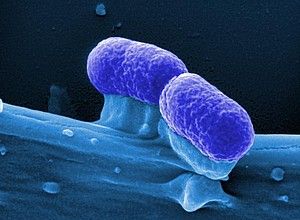Blockade of pathogen's metabolism
The search for new antibiotics: Tiny proteins prevent bacterial gene transcription
In the search for new antibiotics, researchers are taking an unusual approach: They are developing peptides, short chains of protein building blocks that effectively inhibit a key enzyme of bacterial metabolism. Now, scientists at the Helmholtz Institute for Pharmaceutical Research Saarland (HIPS) in Saarbrücken.

Bacteria such as Escherichia coli, shown here in electron microscopic magnification, are susceptible to the novel antibiotic peptides developed by HIPS researchers.
© HZI / Rohde
The road from gene to protein has an important stop along the way: ribonucleic acid, or RNA. This molecule is essentially a "negative copy" of DNA, the cell's hereditary material, and serves as a blueprint for the cell to make proteins, the basic building blocks of life. This "template" is assembled by the enzyme RNA polymerase, whose job it is to read off the information that is stored within the DNA molecule.
Bacterial RNA polymerase consists of several subunits. The core enzyme has to first bind a certain protein molecule called "sigma factor" which essentially allows the enzyme to begin production of the RNA molecule. The sigma factor locates the starting point of the gene to be copied - as soon as its job is done, it once again detaches from the enzyme complex. The next time, the sigma factor and the core enzyme have to bind to each other again. If this is no longer possible, new RNA cannot be synthesized and no more proteins will be made by the cell. Cellular processes come to a complete standstill, and the bacterium dies.
Which is exactly the reason why the point of contact between the sigma factor and the core enzyme represents a potential target for new therapies against bacterial infections. Another feature makes this a particularly attractive target: "Sigma factors are unique to bacteria and are not found in mammalian cells," explains Kristina Hüsecken, Ph.D. student at the HIPS and the publication's first author. "This way, we are able to specifically target the bacteria without putting the body's own cells at risk." Which also means potential side effects are not to be expected.
The drug researchers from Saarbrücken have looked at a range of peptides, short chains of amino acids, capable of inhibiting the polymerase. Their structure corresponds to areas from the binding site of one of the enzyme parts: A perfect fit, the peptides dock either to the core enzyme or to the sigma factor, specifically at the exact location where the counterpart would normally attach to. This way, the components are prevented from combining to form a functional enzyme since the binding site is already occupied. Of the 16 total peptides the researchers examined, one in particular proved especially effective. The peptide called P07 was able to show in further tests that it actually does prevent transcription of DNA to RNA in bacterial cells by interfering with the interaction between sigma and core enzyme.
A number of current antibiotics target bacterial RNA polymerase, among them rifampicin, which was first introduced in the late 1960s. Yet these classic drugs are quickly losing their efficacy, as germs are evolving resistance to them. "Since we're looking at a new mode of action, it won't come to cross resistance, which is a much-feared issue with new antibiotics," says Dr. Jörg Haupenthal, the study's principal investigator. This could be the case with any new substance whose mode of action is similar to that of an antibiotic the bacteria have already evolved resistance to.
Whether or not P07 will be developed into a market-ready drug is something Haupenthal and his colleagues cannot predict. "Even though our research points the way to new and effective antibiotics, actually developing them into full-blown drugs for clinical use requires much additional research," says Haupenthal. As such, the researchers are working at optimizing P07 while also looking for other molecules capable of binding to the same spot on the polymerase enzyme.




















































